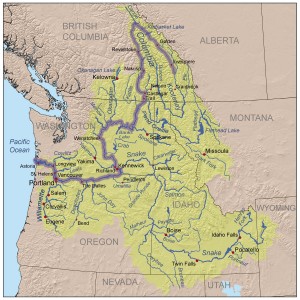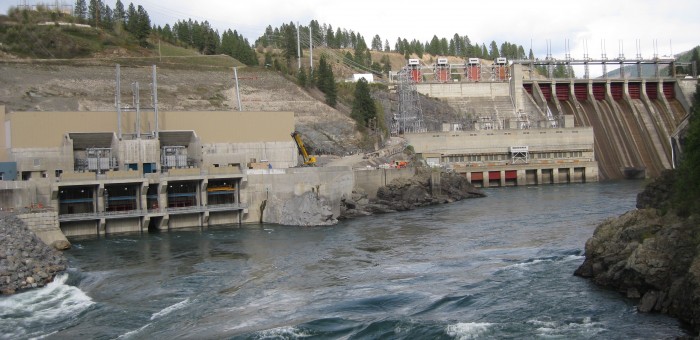Floods, Power and Fish: A Damming History
September 16, 2014 marked the 50th anniversary of the ratification of the Columbia River Treaty. It also triggered the beginning of a ten-year period for renegotiation for which we are now in the middle of the second year. As negotiations continue to evolve, I will provide ongoing analysis of the treaty process. In this, our first post on the topic, I offer a historical review of how we got to where we are today.
 The ~2,000 km long Columbia River begins in British Columbia’s Rocky Mountains and stretches through Washington before reaching the Pacific Ocean northwest of Portland, Oregon. Its drainage basin (including the rivers that flow into and join with it) includes parts of British Columbia, Washington, Idaho, Oregon, Montana, Wyoming, Utah and Nevada. That’s an area of about 670,000 square kilometres which is greater than the size of Alberta.
The ~2,000 km long Columbia River begins in British Columbia’s Rocky Mountains and stretches through Washington before reaching the Pacific Ocean northwest of Portland, Oregon. Its drainage basin (including the rivers that flow into and join with it) includes parts of British Columbia, Washington, Idaho, Oregon, Montana, Wyoming, Utah and Nevada. That’s an area of about 670,000 square kilometres which is greater than the size of Alberta.
The Columbia River has played a pivotal role in the economic development of British Columbia and it all began in the 1930s. During that time, the United States realized that it could harness the Columbia by damming it; it could then use the river for power generation, flood control, channel navigation and irrigation. The United States quickly realized, however, that to truly maximize the potential of the river — and to truly be able to control the possibility of severe flooding — it would also need to harness the river on the Canadian side. This need to enter into transboundary cooperation was underscored when a 1948 flood caused extensive damage from Trail, British Columbia to Astoria, Oregon, completely destroying Vanport, Oregon’s second largest city in a day. Sixteen years later, in 1964, the Columbia River Treaty was formally ratified, allowing for the development and operation of dams in British Columbia and thereby creating power and providing flood control for both Canada and the United States.
After the treaty was signed, British Columbia built three dams that have been continuously used to provide flood management and electrical generation (through hydropower) both in British Columbia and the United States. In return for the construction and extended reciprocal use of these dams, British Columbia receives, from the United States, an annual Canadian Entitlement now valued at between $250 and $350 million. As a result, electricity generated downstream, in the United States, provides nearly half of the city of Los Angeles’ electricity, while water from the dam system irrigates more than 7.3 million acres of previously non-arable land. In addition to the benefits provided to the United States and our own Canadian Entitlement, the Columbia River Basin now provides approximately half of the power generation capacity of British Columbia. So even without knowing it, each and every one of us continues to be affected daily by the 1964 Columbia River Treaty every time we turn on the lights or our televisions.
 It’s pretty clear how British Columbia benefits from the treaty: we get flood control, we get electricity, and we get an annual payment from the United States. For all of its benefits, however, it’s important to consider how the treaty impacts our province. Treaty dams flood almost 600 square kilometres of bottomland in British Columbia and the flooding affected residents of areas that were either flooded or were near the flooding. Furthermore, much of the land impacted is of cultural and titular importance to local First Nations.
It’s pretty clear how British Columbia benefits from the treaty: we get flood control, we get electricity, and we get an annual payment from the United States. For all of its benefits, however, it’s important to consider how the treaty impacts our province. Treaty dams flood almost 600 square kilometres of bottomland in British Columbia and the flooding affected residents of areas that were either flooded or were near the flooding. Furthermore, much of the land impacted is of cultural and titular importance to local First Nations.
In an effort to implement the treaty in a short amount of time, the British Columbia government did not substantively consider the impacts of altering the natural flow of the river. The result of this lack of consideration has meant that the people of the Columbia River basin have neither had much say in the development of the river, nor have they seen substantial direct economic benefits to their communities. This lack of consideration also extended to environmental issues, which, in the 1950s and 60s, were not of paramount importance during the negotiations. The use of British Columbia land, through the treaty, does not identify ecosystem considerations; it does not account for the potential implications of climate change; nor does it include mechanisms that allow for adaptation according to changing environmental, economic and regional conditions. Agriculture — in and around the Columbia River — has been required to change. Local ecosystems have shifted. Fish populations that previously used the river have disappeared or altered their activities. Although we have not “destroyed” the Columbia River basin, we have certainly had an impact on it.
In 1995 the Columbia Basin Trust was set up as after residents, including local government officials and First Nations, of the Columbia Basin approached the British Columbia Government with a request (as taken from the Columbia Basin Trust website):
- funds be allocated to the region, representing a fair share of the ongoing benefits being realized outside of the Basin as a result of the Columbia Basin Trust;
- a regional organization, governed by a board of Basin residents, be created to manage those funds.
As noted above, we are currently in the middle of the second year of a ten-year period of renegotiation. Both the United States and Canada have set up review committees to examine the current treaty and its effects. Both committees have advised that each country would substantially benefit from the continuation of the treaty. The issue becomes more complicated when the committees consider the costs and benefits for each jurisdiction. For example, the United States asserts that Canada is currently receiving more than its fair share of entitlements, while British Columbia believes that intangible benefits to the United States from our own water management are not currently accounted for under the treaty. Moreover, while both parties agree that accommodating environmental factors is a high priority, recommendations on the process for their accommodation vary. One thing that is certain, the negotiation process will ultimately play an important role in deciding the energy future of British Columbia.
Ultimately, the Columbia River Treaty renegotiation offers the potential for British Columbia to continue to play a major role in the energy sector of the Pacific Southwest. Furthermore, it gives British Columbia the opportunity to position itself as a leader in sustainable energy production and transnational energy cooperation.
If you are interested in further information, please consider reading the details of the regional recommendations from the United States and the recommendations from British Columbia. The province of British Columbia also provides information concerning negotiations on an ongoing basis.




